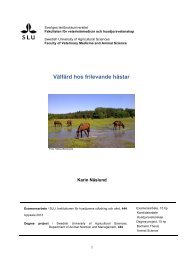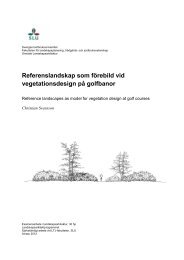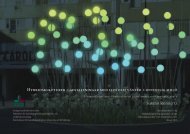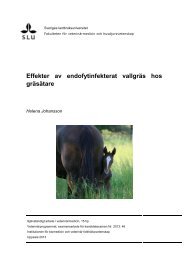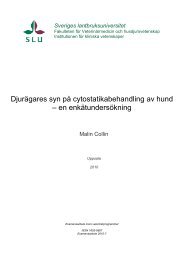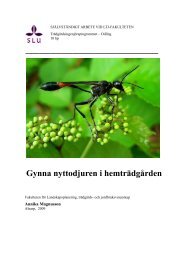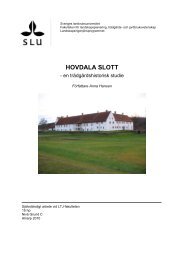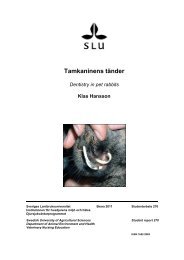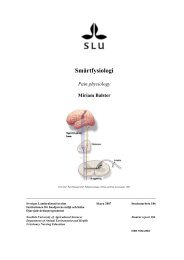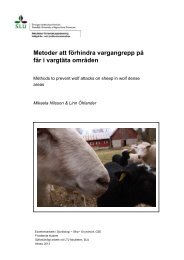Examensarbete i ämnet biologi - Epsilon Archive for Student Projects
Examensarbete i ämnet biologi - Epsilon Archive for Student Projects
Examensarbete i ämnet biologi - Epsilon Archive for Student Projects
Create successful ePaper yourself
Turn your PDF publications into a flip-book with our unique Google optimized e-Paper software.
<strong>Examensarbete</strong><br />
i <strong>ämnet</strong> <strong>biologi</strong> 2013:7<br />
The effects of Gotland pony grazing on <strong>for</strong>est<br />
composition and structure in Lojsta hed,<br />
south eastern Sweden<br />
Emma Andersson<br />
Foto: Anna Ericsson<br />
Sveriges lantbruksuniversitet<br />
Fakulteten för skogsvetenskap<br />
Institutionen för vilt, fisk och miljö<br />
<strong>Examensarbete</strong> i <strong>biologi</strong>, 15 hp, G2E<br />
Umeå 2013
<strong>Examensarbete</strong><br />
i <strong>ämnet</strong> <strong>biologi</strong> 2013:7<br />
The effects of Gotland pony grazing on <strong>for</strong>est<br />
composition and structure in Lojsta hed,<br />
south eastern Sweden<br />
Effekten av hästbete på skogens struktur och sammansättning på Lojsta hed,<br />
sydöstra Sverige<br />
Emma Andersson<br />
Keywords: horse grazing, ground cover, height structure, Gotland, Lojsta hed<br />
Handledare: Lars Edenius och Carl-Gustaf Thulin<br />
Examinator: Jean-Michel Roberge<br />
15 hp, G2E<br />
Kurskod EX0571<br />
SLU, Sveriges lantbruksuniversitet<br />
Fakulteten för skogsvetenskap<br />
Institutionen för vilt, fisk och miljö<br />
Swedish University of Agricultural Sciences<br />
Faculty of Forestry<br />
Dept. of Wildlife, Fish, and Environmental Studies<br />
Umeå 2013
Abstract<br />
Livestock animals affect their environment in a number of different ways, mostly through<br />
grazing and trampling. This study focused on the effects of Gotland pony grazing on <strong>for</strong>est<br />
structure and diversity, and the impact on ground cover. To compare the fenced and grazed<br />
area with a reference area outside the enclosure a number of transects were used. The study<br />
showed that there was no significant difference in height structure and diversity between the<br />
compared sites; however, there were a significantly higher proportion of damaged trees inside<br />
the enclosure. The ground cover variables showed a higher amount of bare soil, plant litter<br />
and wood-rush (Luzula sp.) inside the enclosure whilst grass was more frequent in the<br />
reference area. This is probably promoting disturbance-tolerant species. However, the results<br />
do indicate that the higher amount of grazing might be homogenizing the <strong>for</strong>ests undergrowth.<br />
The implications of this study suggest that the way the horses are kept need to be modified in<br />
order to continue to maintain the desired open <strong>for</strong>est structure. Due to the lack of knowledge<br />
on the horses’ effect on ecosystem functions further studies on other taxa is advisable as well.<br />
Sammanfattning<br />
Herbivorer påverkar sin omgivning på en mängd olika sätt, bland annat genom bete och<br />
tramp. Den här studien utfördes vid Lojsta hed på Gotland och behandlar effekten av betande<br />
hästar på trädsamhällets höjdstruktur och diversitet samt marktäckningsfaktorer. Studien är en<br />
jämförelse mellan ett hägnat område som årligen betas av russ mellan juli-november, och ett<br />
referensområde utanför hägnet. Genomgående återfanns ingen effekt på höjdstruktur eller<br />
diversitet, men andelen skadade träd var högre inom det hägnade området. Marktäckningen<br />
var påverkad på så vis att det var en högre andel bar mark, förna och fryle (Luzula sp.) inom<br />
det hägnade området medan andelen gräs var högre i referensområdet. Resultatet antyder<br />
också att hästarna har en homogeniserande effekt på de lägre trädskikten i skogen. Hästarnas<br />
närvaro gynnar förmodligen också arter som är störningstoleranta. Studien föreslår att sättet<br />
hästarna hålls på kan behöva modifieras för att <strong>for</strong>tsätta bidra till öppethållandet av skogen. På<br />
grund av den bristande mängden kunskap om hästarnas effekt på ekosystemet är <strong>for</strong>tsatta<br />
studier i <strong>ämnet</strong> av stort intresse.<br />
3
Introduction<br />
Grazing megafauna and historic land use<br />
A contested theory is that <strong>for</strong> thousands of years ago large mammalian herbivores like wild<br />
bovids and equids roamed Europe <strong>for</strong>ming parts of the landscape into relatively open <strong>for</strong>ested<br />
grasslands (Olff et al. 1999, Pykälä 2000, Donlan et al. 2005). When humans colonized these<br />
areas the grazing megafauna was hunted and became partially extinct which altered the<br />
ecosystem (Donlan et al. 2005, 2006) into a more tree and shrub dominated landscape<br />
(Fahnestock & Detling 1999, Öckinger et al. 2006). The megafauna was to some extent<br />
replaced by human agriculture and grazing by domesticated livestock such as sheep, cattle<br />
and horses (Pykälä 2000), but the amount of small-scale farming and grazing are currently<br />
declining in many parts of Europe. In Sweden about 70% of meadows and grazing pastures<br />
have been lost over the years 1891-2007 (Figure 1; Jordbruksverket 2012). The biodiversity<br />
of such areas will continue to decrease (Axelsson Linkowski 2012, Jordbruksverket 2012) and<br />
traditional ecosystem functions and cultural values are also threatened by this decline in<br />
small-scale farming. (Kuijper et al. 2010a, Axelsson Linkowski 2012).<br />
Hectare<br />
1800000<br />
1600000<br />
1400000<br />
1200000<br />
1000000<br />
800000<br />
600000<br />
400000<br />
200000<br />
0<br />
1891<br />
1906<br />
1919<br />
1937<br />
1956<br />
1968<br />
1971<br />
1974<br />
1977<br />
1980<br />
1983<br />
1986<br />
1989<br />
1992<br />
1995<br />
1998<br />
2005<br />
Year<br />
Figure 1. The decline in meadows and grazing pastures in Sweden 1891-2007<br />
(Jordbruksverket 2008).<br />
In Sweden there is a long history of keeping pastures and grazing in <strong>for</strong>ests, all which have<br />
reassured the biodiversity of semi open landscapes. However, the declines in agricultural<br />
methods like small-scale farming and grazing pastures are now starting to worry<br />
conservationists (Axelsson Linkowski 2012). A phenomenon related to this is that <strong>for</strong> each<br />
new generation what is considered base line conditions will shift so that a degraded state is<br />
considered normal, which is known as the shifting baseline syndrome (Pauly 1995). In the<br />
Netherlands the use of free-ranging livestock, primarily cattle and horses, as an introduced<br />
part of the ecosystem is quite common (Olff et al. 1999, Kuiters & Slim 2003) but in many<br />
4
places the importance of traditional animal husbandry as a conservation tool is insufficiently<br />
known (Axelsson Linkowski 2009, Rigueiro-Rodriguez et al. 2012).<br />
Ungulates and their effect on their environment<br />
Both wild and domesticated ungulates affect their environment directly or indirectly, either as<br />
grazers who feed primarily on grass and <strong>for</strong>bs or as browsers, which prefer to feed on woody<br />
vegetation (Holdo et al. 2009). The effects mammalian herbivores have on plant communities<br />
vary with a number of factors and the plants response will also differ depending on herbivory<br />
type, timing, intensity and frequency (Fahnestock & Detling 1999, Pykälä 2000). The<br />
environmental resources available <strong>for</strong> growth will also affect the plants (Fahnestock &<br />
Detling 1999).<br />
A study made by Kuijper et al. (2010a) at Bialowieza Primeval Forest in Poland shows that<br />
browsing ungulates such as moose (Alces alces) and roe deer (Capreolus capreolus) and<br />
intermediate feeders such as European bison (Bison bonasus) and red deer (Cervus elaphus)<br />
influence both total tree recruitment and species composition of trees recruiting into a size<br />
class of >50 cm. Kuijper et al. (2010a) also suggest that the composition of the mature tree<br />
stands probably are affected by the pressure carried out by ungulates on trees in early life<br />
stages.<br />
Horses (Equus sp.) are considered typical grazers and mostly affect their surroundings by<br />
trampling and grazing on grass and herbaceous plants (Duncan 1992). They also affect their<br />
environment through seed dispersal, thereby favoring the establishment of disturbancedependent<br />
and/or grazing tolerant species (Kuiters & Slim 2003). A study made by Kuiters &<br />
Slim (2003) showed that horses, in con<strong>for</strong>mity with browsing ungulates, can prevent the<br />
regeneration of trees through grazing, but since free-ranging horses are rather selective in<br />
habitat use and prefer grasslands over woodlands the total impact on the tree community may<br />
not be as large as expected. However, Olff et al. 1999 showed that horses grazing<br />
unselectively on grass could unintended graze on small seedlings, affecting the recruitment of<br />
trees.<br />
The Gotland pony and Lojsta hed<br />
The Gotland pony is believed to have arrived to Gotland about 5000 years be<strong>for</strong>e present as<br />
indicated by archaeological findings of horse remains from the Iron Age (Ejendal &<br />
Hollström 2004, Hollström 2010). How the pony came to Gotland is uncertain, but since there<br />
is no evidence of a <strong>for</strong>mer land bridge between Gotland and the mainland (NE.se 2013) the<br />
ponies are likely brought to the island by humans (Hollström 2010).<br />
The ponies were used <strong>for</strong> farm work, but there were also free roaming ponies all over the<br />
<strong>for</strong>ested areas of southern Gotland. There were no fences and the ponies fed on whatever they<br />
could find (Lojstahedrussen.se 2013). During the later parts of the 19th century there was a<br />
severe decline in the free-roaming population due to hunting and selling of the ponies. During<br />
early 20th century there were only about 150 free roaming individuals left, and in the 1910s<br />
the breeding in the wild had stopped completely and only eight ponies remained. These ponies<br />
5
were rounded up and protected within a 100 hectare fenced area named Lojsta hed and all<br />
living Gotland ponies originate from these eight individuals (Hollström 2010,<br />
Lojstahedrussen.se 2013). In 1932 the fenced area at Lojsta hed was extended to cover about<br />
450 hectares (Hollström 2010).<br />
The current pony population at Lojsta hed<br />
Today Lojsta hed is a reserve where the ponies are kept under relatively feral conditions.<br />
Since 1984 the reserve covers about 650 hectares of <strong>for</strong>est in various succession stages, mires<br />
and more open but still <strong>for</strong>ested areas. During the year the horses are moved between three<br />
enclosures in the reserve depending on season. Since overall size of the enclosures varies, the<br />
density of animals in them also varies (Table 1; Lojstahedrussen.se 2013).<br />
This keeping of horses, where the ponies are semi-domesticated and are born, live and die on<br />
Lojsta hed, is unique in Sweden. They are only rounded up a few times every year to get hoof<br />
care, change enclosure, be evaluated <strong>for</strong> the studbook or have the foals separated from the<br />
herd. The overall ambition with this horse facility is to conserve the breed in a historical <strong>for</strong>m,<br />
involving genetics and the cultural heritage of “free roaming” horses on Gotland (Ejendal &<br />
Hollström 2004, Hollström 2010). According to the County Administrative Board (2004) the<br />
horses also play an important role in keeping the <strong>for</strong>est in a desired open stage in the nature<br />
reserves at Lojsta hed.<br />
The Gotland pony is one of the last of Sweden’s native horse breeds, classified as endangered<br />
by the European Union (Lojstahedrussen.se 2013). As <strong>for</strong> all other European horse breeds it is<br />
believed that the Gotland pony originated from the wild tarpan (Equus ferus ferus) (Ejendal &<br />
Hollström 2004, Hollström 2010). In the reserve the horses feed on the available vegetation,<br />
except during winter when they are supplementary fed with hay every other day. In the spring<br />
during the foaling period the mares also get concentrated fodder (Ingvar Andersson, pers.<br />
comm. 2013).<br />
There are about 50 mares in the pony reserve during winter, so when the foals arrive the herd<br />
expands up to approximately 80 animals. Each year between June and late August a stallion<br />
also joins the herd to facilitate reproduction (Ejendal & Hollström 2004). The number of<br />
horses in the herd is regulated through the removal of foals during fall. A couple of filly-foals<br />
are saved in the herd to compensate <strong>for</strong> losses due to age, while the rest of the foals are sold<br />
on the open market to become riding ponies or pony trotters. Old broodmares who are no<br />
longer productive are put down after two years of not having a foal (Ingvar Andersson, pers.<br />
comm. 2013).<br />
Table 1. Residential time and density of ponies in the different enclosures.<br />
Enclosure Duration Size (ha) Density/1000 ha Notes<br />
Fall July-November 300 167-266 One stallion, around 50 mares and 30 foals<br />
Winter November-June 150 333 About 50 mares and youngsters<br />
Summer June-July 200 250-400 One stallion, around 50 mares and 30 foals<br />
6
Aim of the study<br />
The aim of this study was to determine if the ponies on Lojsta hed through their grazing and<br />
trampling are affecting the plant community, focusing on tree and shrub height structure,<br />
composition of woody plants and ground cover. The following hypothesises were tested:<br />
1. The ponies are affecting the <strong>for</strong>est structure by altering the recruitment of young<br />
(small) tree plants into the tree community either directly through their feeding<br />
activities or indirectly through trampling.<br />
2. The diversity of trees and shrubs in the enclosed area should be higher than in the<br />
reference area due to the ponies feeding and trampling activities.<br />
3. Feeding activities by high density of ponies should result in a lower amount of grass<br />
inside the enclosure. Furthermore, due to trampling the proportion of bare ground<br />
should be higher inside the enclosure.<br />
Materials and method<br />
The study area<br />
The study area is located on the island of Gotland (N 57°30', E 18°33') outside the Swedish<br />
southeast coast (Figure 2). Mean precipitation is about 600 mm per year and the area has a<br />
mean year temperature of 7 o C (SMHI 2009). The inner parts of the island have continental<br />
climate and the island is quite windy all year round (SMHI 2013). The bedrock of Gotland<br />
consists mainly of limestone and the soil types both inside the enclosure and in the reference<br />
area are till and washed sediments (SGU 2013).<br />
Figure 2. The location of Gotland and the study area Lojsta hed (Lojstahedrussen.se 2013).<br />
7
In addition to horses there is also roe deer and European hare (Lepus europaeus) browsing in<br />
the area. Mountain hare (Lepus timidus) and common rabbit (Oryctolagus cuniculus) are also<br />
present on the island, but whether or not they occur within the survey area is unclear.<br />
Survey method<br />
The possible effects of ponies on the vegetation was surveyed in transects 50 m long and 2 m<br />
wide, with 25 transects inside the enclosure and 23 outside (Figure 3). For the survey the<br />
enclosure used by the horses during July-November was chosen. This area was chosen <strong>for</strong><br />
three reasons; 1) here the horses spend the most amount of time, 2) the northern parts of the<br />
enclosure, where the survey was done, is a nature reserve where no <strong>for</strong>est management<br />
actions have been done <strong>for</strong> a long time (County Administrative Board 2004) and 3) the ponies<br />
are not supplementary fed during this time period (Ingvar Andersson, pers. comm. 2013). The<br />
<strong>for</strong>est in the survey area consisted of older <strong>for</strong>est dominated by pine (Pinus sylvestris) in the<br />
canopy and alder buckthorn (Rhamnus frangula) and juniper (Juniperus communis) in the<br />
undergrowth (County Administrative Board 2004).<br />
The reference sites were preferentially without traces of <strong>for</strong>estry and resent grazing from<br />
livestock animals.<br />
The starting points <strong>for</strong> the transects inside the enclosure were randomly chosen using a<br />
100x100m grid covering the selected <strong>for</strong>est type, this was done using the software ArcGIS 10.<br />
The starting points <strong>for</strong> the reference sites were chosen in a similar biotope. The direction of<br />
the transect from the starting point was randomized in advanced with eight possible outcomes<br />
– S, N, W, E, SE, SW, NE and NW.<br />
Trees<br />
Variables collected along each transect included:<br />
- Species (trees and shrubs)<br />
- Height in classes (0,2-3 m (seedlings), 3-5 m (saplings), 5-10 m, 10-15 m, 15-20 m,<br />
20> m)<br />
- Damage (browsed twigs, gnawing on bark and undefined damage was separated)<br />
- Diameter at breast height (<strong>for</strong> trees ≥1,3 m)<br />
- Status (Alive, dead standing, dead fallen)<br />
Trees were counted if more than half the trunks width was inside the transect border (within<br />
one meter from the measuring tape). Fallen trees were counted if the butt was located inside<br />
the transect. If a tree was split underneath ground surface it was counted as two or more<br />
individuals, and if it was split above ground as one.<br />
Ground cover<br />
Variables of presence/absence included:<br />
- Ground coverage (Table 2) beneath metre marking 0-49 m, 50 points/transect<br />
- Faeces from horse and roe deer, if the measuring tape ran over it<br />
8
Coordinates of the starting point were noted from the GPS, which was placed at the starting<br />
point in the beginning.<br />
All data was logged in Allegro field collector and all maps were made using ArcGIS 10.<br />
Figure 3. The starting points of each transect.<br />
9
Data analysis<br />
Effects on height structure<br />
Trees were assigned to different height classes to evaluate the effect of pony feeding activities<br />
on height structure. Because of the higher amount of seedlings (3 m), only seedling size classes were included in the<br />
analysis. Dead standing trees was included in the analysis and the trees
eference area, however, there was no significant difference (P>0,05, Figure 4a). The CV is<br />
displayed in Figure 4b.<br />
4a)<br />
Individuals/100 m<br />
30<br />
25<br />
20<br />
15<br />
10<br />
5<br />
0<br />
Enclosure<br />
Reference<br />
Height class (m)<br />
4b)<br />
Coefficient of variation<br />
400,00%<br />
350,00%<br />
300,00%<br />
250,00%<br />
200,00%<br />
150,00%<br />
100,00%<br />
50,00%<br />
0,00%<br />
Enclosure<br />
Reference<br />
Height class (m)<br />
Figure 4. a) Mean number of tree and shrub individuals in each height class per 100 m 2 . Red<br />
bars represent the standard error of the mean. b) CV in each height class.<br />
The four most occurring tree and shrub species inside the enclosure was alder buckthorn,<br />
juniper, birch (Betula sp.) and mountain-ash (Sorbus aucuparia). There was no significant<br />
difference in the height structure <strong>for</strong> either of the species (P>0,05; Figure 5a). The co-variance<br />
is displayed in Figure 5b.<br />
11
5a)<br />
Alder buckthorn<br />
Juniper<br />
15<br />
15<br />
10<br />
10<br />
5<br />
5<br />
0<br />
0<br />
Individuals/100 m 2<br />
10<br />
8<br />
6<br />
4<br />
2<br />
0<br />
Birch<br />
8<br />
6<br />
4<br />
2<br />
0<br />
Mountain-ash<br />
Height class (m)<br />
5b)<br />
Alder buckthorn<br />
Juniper<br />
Coefficient of variation<br />
1000%<br />
800%<br />
600%<br />
400%<br />
200%<br />
0%<br />
800%<br />
Birch<br />
800%<br />
600%<br />
400%<br />
200%<br />
0%<br />
1500%<br />
Mountain-ash<br />
600%<br />
400%<br />
200%<br />
1000%<br />
500%<br />
0%<br />
0%<br />
Height class (m)<br />
Figure 5. a) Mean number of individuals of the four most common species’ in each height<br />
class per 100 m 2 . Black bars represent the enclosure, grey bars the reference area and red bars<br />
the standard error of the mean. b) CV in each height class.<br />
12
Damage to trees<br />
There was a significantly higher proportion of damaged tree and shrub individuals inside the<br />
enclosure (P=0,03). The amount of trees damaged through browsing or gnawing on the bark<br />
decreased with increasing height (Figure 6).<br />
Proportion of damaged individuals<br />
0,35<br />
0,3<br />
0,25<br />
0,2<br />
0,15<br />
0,1<br />
0,05<br />
0<br />
Enclosure<br />
Reference<br />
Linjär (Enclosure)<br />
Linjär (Reference)<br />
R² = 0,7636<br />
R² = 0,5862<br />
Height class (m)<br />
Figure 6. Correlation between tree height and proportion of damaged trees.<br />
Diversity of trees and shrubs<br />
The diversity of each height class was compared between the sites, but there was no clear<br />
difference (Figure 7).<br />
0,900<br />
Simpsons index of diversity<br />
0,850<br />
0,800<br />
0,750<br />
0,700<br />
0,650<br />
Enclosure<br />
Reference<br />
Height class (m)<br />
Figure 7. Simpsons index of diversity <strong>for</strong> each height class.<br />
13
Effects on ground vegetation<br />
All collected ground cover variables are displayed in Table 2. Plant litter, bare soil and wood<br />
rush were significantly more frequent in the enclosure (Plant litter; P
Proportion<br />
50%<br />
45%<br />
40%<br />
35%<br />
30%<br />
25%<br />
20%<br />
15%<br />
10%<br />
5%<br />
0%<br />
*<br />
*<br />
* *<br />
Enclosure<br />
Reference<br />
Ground cover<br />
Figure 8. Arithmetic mean and standard error of mean (red bars) <strong>for</strong> the different ground<br />
cover types.<br />
Discussion<br />
Effect on height structure and damaged trees<br />
There were no significant differences in tree and shrub height between the compared sites; the<br />
first hypothesis could there<strong>for</strong>e not be verified. The fact that there was no significant<br />
difference might depend on that horses due to their feeding ecology in most cases do not<br />
graze directly on woody plants (Duncan 1992). This result is in contrast with earlier studies<br />
made by Kuiters & Slim (2003), Buttler et al. (2008) and Kuijper et al. (2010a), but in line<br />
with a study made by Vandenberghe et al. (2007). Vandenberghe et al. (2007) concludes that<br />
cattle, which in con<strong>for</strong>mity with horses are primarily grazers, affect the biomass of trees, but<br />
not necessarily the regeneration of small seedlings.<br />
The variance of the mean, and the CV, was much larger <strong>for</strong> individuals in the reference area,<br />
particularly in the 0.8-1 m class when all trees were included. This indicate that the horses’<br />
presence, or the combined effect of horses and roe deer, could have a homogenizing effect on<br />
the height structure, which has been shown by Mathisen et al. (2010) on browsing animals<br />
such as moose.<br />
The impact of horses on the tree and shrub community might have been stronger and/or<br />
different if the density of horses had been as high as the current population during the whole<br />
time period. Fluctuations in herbivore density were suggested by Kuijper et al. (2010b) to<br />
allow more natural and diverse <strong>for</strong>est development, whilst constant size of population could<br />
lead to single species, even aged stands.<br />
15
The fact that the horses are moved between the enclosures during the year could also affect<br />
the outcome of the result. As showed by Kuiters & Slim (2003) there is a shift in habitat use<br />
as the grazing season proceeds, with a higher preference <strong>for</strong> grazing in more <strong>for</strong>ested areas<br />
later in the season. The horses would also seek shelter in the woodlands during night, but<br />
during this time they would mostly rest, not graze.<br />
Trampling by the ponies probably affect the seedlings, which is in line with the findings of<br />
Liss (1988), that other livestock, such as cattle, mostly damages trees through trampling.<br />
Furthermore, Mayer et al. (2006) suggested that cattle also cause damage while scratching<br />
themselves on available woody plants. This could probably also be applied on the horses in<br />
this study, although this was not surveyed.<br />
Diversity among trees and shrubs<br />
The second hypothesis, concerning diversity among trees and shrubs, was not confirmed.<br />
Both inside and outside the enclosure the diversity was highest in the lowest height classes<br />
and decreased with increasing height. The amount of damage on trees and shrubs also follows<br />
the same pattern. Several studies has shown that an intermediate disturbance enhances<br />
diversity (Collins et al. 1995, Mathisen et al. 2010, Mayor et al. 2012), which might suggest<br />
that the amount of grazing both inside and outside the enclosure is of intermediate nature.<br />
The effect of the ponies might be more obvious in a study focusing on other vascular plants,<br />
rather than trees. There could also be effects on other taxa, as shown in Öckinger et al. (2006)<br />
where both vascular plants and butterflies were positively affected by grassland management<br />
actions like grazing.<br />
Ground cover<br />
The significant differences in the proportion of grass and bare soil indicate that the horses, as<br />
stated in the third hypothesis, have a defined impact on the ground cover. Since horses graze<br />
primarily on grass (Duncan 1992) the logical outcome is that grass is less common in a grazed<br />
area. Observations made in the field also support that the differences in the amount of bare<br />
ground is due to trampling. This probably benefits species able to cope with a disturbed<br />
environment, which has been shown in previous studies (Kuijper et al. 2010b, Rigueiro-<br />
Rodriguez et al. 2012).<br />
There could also be secondary effects of the horses’ presences in the area; they are likely to<br />
facilitate seed dispersal and soil fertilization through their excrements, which has been<br />
showed in studies concerning other livestock animals. The work of Fisher et al. (1996)<br />
showed that during one summer one sheep could transport up to 8500 seeds from a number of<br />
different vascular plants, whilst Buttler et al. (2008) showed that excrements from cattle<br />
modified diversity by facilitating more nitrophilous species in areas with faeces and liquid<br />
excrements.<br />
16
Further notions<br />
It is important to remember that the historical land use on Gotland may have influenced the<br />
study. It is hard, if not impossible, to find <strong>for</strong>ests that are not affected by <strong>for</strong>est management<br />
and/or historical agriculture. Horses have also been roaming freely on the island <strong>for</strong> about<br />
5000 years, but only been fenced in this area <strong>for</strong> about 80 years. This may have affected the<br />
reference sites.<br />
Conclusion<br />
According to the County Administrative Board (2004) the ponies play an important part in the<br />
maintenance of the nature reserve in the northern part of the fall enclosure. The action plan<br />
states that the ponies contribute to keep the <strong>for</strong>est in a desired open stage, but since this<br />
survey did not completely support this theory the management actions of the nature reserve is<br />
questionable. It may there<strong>for</strong>e be relevant to modify the way the horses are kept so they can<br />
continue to contribute to the openness of the <strong>for</strong>est.<br />
The rotation between the enclosures, and the supplementary feeding in the winter enclosure,<br />
probably prevents some of the impacts that could be done by the horses. Winter is the time<br />
when the ponies are expected to graze mostly in woodlands (Kuiters & Slim 2003), and<br />
there<strong>for</strong>e apply the most pressure on the vegetation. As the rotation and supplementary<br />
feeding proceeds these effects could be partially undermined, or even prevented, which in turn<br />
could influence the positive effects on diversity. Furthermore, the effects on diversity in one<br />
area could affect that of another, since the source and dispersal possibilities of different plant<br />
species may be altered.<br />
Other livestock animals, such as goats, would probably have a more pronounced effect on the<br />
recruiting trees since they feed more intense on all available vegetation (Wood 1987).<br />
Trampling, excrements and grazing all contribute to creating a more heterogeneous habitat,<br />
which in the long run should facilitate higher biodiversity among both flora and fauna.<br />
That the horses do not seem to influence the regeneration of trees opens up <strong>for</strong> an expansion<br />
<strong>for</strong> this type of horse keeping, and maybe <strong>for</strong> other grazers and intermediate feeders as well.<br />
For example, it could be combined with horsemeat production and/or rewilding projects with<br />
horses.<br />
Future studies<br />
It would be highly interesting to further look in to the processes and interactions between<br />
these animals and their environment. This pilot study opens up <strong>for</strong> further investigations on<br />
how the ponies affect the diversity, soil, flora and fauna.<br />
17
Acknowledgements<br />
First of all I’d like to thank my supervisors Lars Edenius and Carl-Gustaf Thulin <strong>for</strong> the<br />
opportunity to do this study and <strong>for</strong> valuable advice along the way, I’m also grateful to Joris<br />
Cromsigt <strong>for</strong> his knowledge and advice on theoretical matters. Also I’d like to thank Ingvar<br />
Andersson, superintendent at Lojsta hed, <strong>for</strong> sharing his knowledge about the Gotland ponies<br />
and Lojsta hed, and finally a great thanks to Johan Fahlman <strong>for</strong> inputs, proof-reading and a<br />
never ending support.<br />
References<br />
Axelsson Linkowski, W. 2009. Utmarksbete, främst skogsbete, och dess effekter på <strong>biologi</strong>sk<br />
mångfald. Centrum för <strong>biologi</strong>sk mångfald. Uppsala.<br />
Buttler, A., Koher, F. and Gillet, F. 2008. The Swiss Mountain Wooded Pastures: Patterns and<br />
Processes. Agro<strong>for</strong>estry in Europe. 6:377–396.<br />
Collins, S L., Glenn, S M., and Gibson, D J. 1995. Experimental Analysis of Intermediate<br />
Disturbance and Initial Floristic Composition: Decoupling Cause and Effect. Ecology.<br />
76(2):486-492<br />
County Adminsistrativ Board. 2004. Länsstyrelsen Gotlands län, Beslut om bildande av<br />
naturreservatet Botes källmyr, Gerum och Linde socknar, Gotlands kommun.<br />
Donlan, J., Berger, J., Bock, E C., Bock, J H., Burney, D A., Estes, J A., Foreman, D., Martin,<br />
P S., Roemer, G W., Smith F A., Soulé M E. and Greene H W. 2005. Re-wilding North<br />
America. Nature. 436:913-914<br />
Donlan, J., Berger, J., Bock, E C., Bock, J H., Burney, D A., Estes, J A., Foreman, D., Martin,<br />
P S., Roemer, G W., Smith F A., Soulé M E. and Greene H W. 2006. Pleistocene<br />
rewilding: An optimistic agenda <strong>for</strong> twenty-first century conservation. The American<br />
Naturalist. 168(5):660-681.<br />
Duncan, P. 1992. Horses and grasses – The nutritional ecology of equids and their impact on<br />
the Camargue. Ecological studies 87. Springer Verlag, New York.<br />
Ejendal, B. and Hollström, H. 2004. De gotländska skogsrussen. Dialogos förlag, Stockholm.<br />
Fahnestock, J T. and Detling J K. 1999. The influence of herbivory on plant cover and species<br />
composition in the Pryor Mountain Wild Horse Range, USA. Plant Ecology. 144:145-157<br />
Fischer, S F., Poschlod, P. and Beinlich, B. 1996. Experimental studies on the dispersal of<br />
plants and animals on sheep in calcareous grasslands. Journal of Applied Ecology.<br />
33:1206–1222.<br />
Holdo, M R., Holt, R D. and Fryxell, J M. 2009. Grazers, browsers, and fire influence the<br />
extent and spatial pattern of tree cover in Serengeti. Ecological Applications. 19(1):95-109<br />
Hollström, H. 2010. Skogsrussen på Lojsta hed. Dialogos förlag, Stockholm.<br />
Jordbruksverket. 2008. Jordbruksverkets statistikdatabas. Historisk statistik. Kap.1 Företag<br />
och ägoslag. http://statistik.sjv.se/Database/Jordbruksverket/databasetree.asp 2013-05-07<br />
Jordbruksverket. 2012. Jordbruket i siffror 1866-2007.<br />
Kuijper, D P J., Joris, P., Cromsigt, G M., Jedrzejewska, B., Miscicki, S., Churski, M.,<br />
Jedrzejewski, W. and Kweczlich I. 2010a. Bottom-up versus top-down control of tree<br />
regeneration in Bialowieza Primeval Forest, Poland. Journal of Ecology. 98:888-899.<br />
18
Kuijper, D P J., Jedrzejewska, B., Brzeziecki, B., Churski, M., Jedrzejewski, W. and Zybura,<br />
H. 2010b. Fluctuating ungulate density shapes tree recruitment in natural stands of the<br />
Bialowieza Primeval Forest, Poland. Journal of Vegetation Science. 21:1082-1098<br />
Kuiters, A T. and Slim, P A. 2003. Tree colonisation of abandoned arable land after 27 years<br />
of horse-grazing: the role of bramble as a facilitator of oak wood regeneration. Forest<br />
Ecology and Management. 181:239-251<br />
Liss B.-M. 1988. Der Einfluss von Weidevieh und Wild auf die natürliche und künstliche<br />
Verjüngung im Bergmischwald der ostbayerischen Alpen. Forstwissenschaftliches<br />
Centralblatt 107(1):14-25<br />
Lojstahedrussen.se. 2013. www.lojstahedrussen.se 2013-04-29<br />
Mathisen, K M., Buhtz, F., Danell, K., Bergström, R., Skarpe, C., Souminen, O. and Persson,<br />
I L. 2010. Moose density and habitat productivity affects reproduction, growth and species<br />
composition in field layer vegetation. Journal of Vegetation Science. 21:705-716<br />
Mayer, A C., Stöckli, V., Konold, W. and Kreuzer, M. 2006. Influence of cattle stocking rate<br />
on browsing of Norway spruce in subalpine wood pastures. Agro<strong>for</strong>estry Systems. 66:143-<br />
149<br />
Mayor, S J., Cahill, J F., He, P., Solymos, P. and Boutin, S. 2012. Regional boreal<br />
biodiversity peaks at intermediate human disturbance. Nature Communications. 3:1142<br />
NE.se. 2013. Landbrygga. http://www.ne.se/lang/landbrygga 2013-04-29<br />
Olff, H., Vera, F W M., Bokdam, J., Bakker, E S., Gleichman, J M., de Maeyer, K. and Smit,<br />
R. 1999. Shifting mosaic in grazed woodlands driven by the alternation of plant<br />
facilitation and competition. Plant Biology. 1:127-137<br />
Pauly, D. 1995. Anecdotes and the shifting baseline syndrome of fisheries. Tree. 10:430<br />
Pykälä, J. 2000. Mitigating human effects on European biodiversity through traditional animal<br />
husbundry. Conservation Biology. 14(3):705-712<br />
Rigueiro-Rodriguez, A., Mouhbi, R., Santiago-Freijanes, J J., del Pilar Gonzáles-Hernández,<br />
M. and Mosquera-Losada, M. 2012. Horse grazing systems: understory biomass and plant<br />
biodiversity of a Pinus radiata stand. Scientia Agricola. 69(1):38-46<br />
SMHI Klimatdata 1961-1990, 2009. www.smhi.se 2013-04-17<br />
SMHI. 2013. Gotlands klimat http://www.smhi.se/kunskapsbanken/meteorologi/gotlandsklimat-1.4887<br />
2013-05-13<br />
SGU. 2013. Sveriges Geologiska Undersökning, Kartgeneratorn. www.sgu.se 2013-05-02<br />
Vandenberghe, C., Francois Freléchoux, F., Moravie, M., Gadallah, F. and Buttler A. 2007<br />
Short-term effects of cattle browsing on tree sapling growth in mountain wooded pastures.<br />
Plant Ecology. 188:253-264<br />
Wood, G M. 1987. Animals <strong>for</strong> <strong>biologi</strong>cal brush control. Agronomy Journal. 79(2):319-321<br />
Öckinger, E., Eriksson, A., and Smith, H G. 2006. Effects of grassland abandonment,<br />
restoration and management on butterflies and vascular plants. Biological conservation.<br />
133:291-300<br />
19
SENASTE UTGIVNA NUMMER<br />
2012:4 The shift in <strong>for</strong>est and tree limits in Troms County – with a main focus on temperature<br />
and herbivores.<br />
Författare: Kristoffer Normark<br />
2012:5 Clover (Trifolium spp) gamefields: Forage product ion, utilization by ungulates and<br />
browsing on adjacent <strong>for</strong>est.<br />
Författare: Karl Komstedt<br />
2012:6 Habitat use and ranging behaviour of GPS tracked juvenile golden eagles (Aquila<br />
chrysaetos).<br />
Författare: Carolin Sandgren<br />
2012:7 Spatial and temporal variation in the quality of summer foods <strong>for</strong> herbivores along a<br />
latitudinal gradient.<br />
Författare: Michaela Holá<br />
2012:8 Hur livshistoriekaraktärer hos Europeisk abborre (Perca fluviatilis L.) påverkas av<br />
cykliska förändringar i populationsstrukturen.<br />
Författare: Christian Andersson<br />
2012:9 Neighborhood effects as a plant defence against ungulate herbivory.<br />
Författare: Bregje Koster<br />
2012:10 Comparison of bird communities in stands of introduced lodgepole pine and native<br />
Scots pine in Sweden.<br />
Författare: Arvid Alm<br />
2013:1 Site fidelity of a migratory species towards its annual range.<br />
Författare: Peter Lojander<br />
2013:2 Selection of habitat and resources during migration by a large mammal – A case study<br />
of moose in northern Sweden.<br />
Författare: Jens Lindberg<br />
2013:3 Predicting spawning bed erosion and longevity: a case study in tributaries to river<br />
Vindelälven, northern Sweden.<br />
Författare: Viktor Tylstedt<br />
2013:4 Passage efficiency and migration behavior <strong>for</strong> adult Atlantic salmon at a Half-Ice<br />
Harbor fish ladder.<br />
Författare: Robert Karlsson<br />
2013:5 Will Atlantic salmon (Salmo salar L.) colonize restored tributaries in the river<br />
Vindelälven, northern Sweden?<br />
Författare: Erik Mellgren<br />
2013:6 The influence of <strong>for</strong>estry stands treatments on brown bears (Ursus arctos) habitat<br />
selection in Sweden – an option <strong>for</strong> Alberta <strong>for</strong>estry?<br />
Författare: Anna Maria Petré<br />
Hela förteckningen på utgivna nummer hittar du på www.slu.se/viltfiskmiljo




